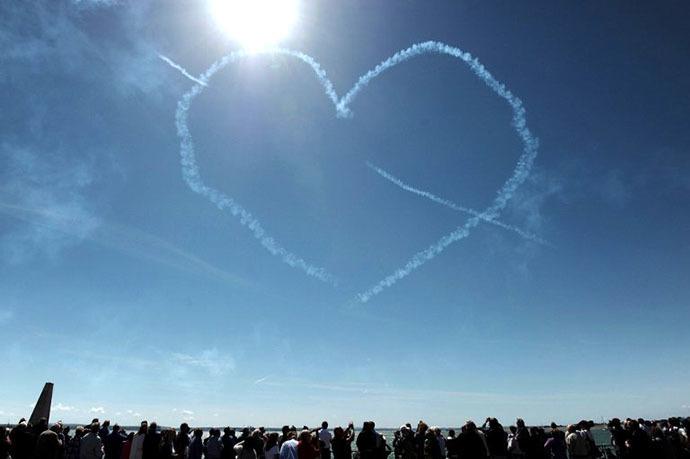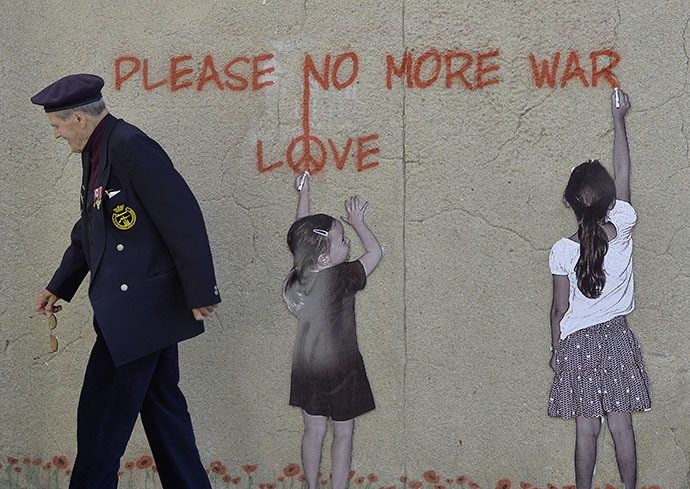D-Day tribute: Rare images of bravery and sacrifice

The 70th anniversary of the largest seaborne invasion in written history and one of the turning points of WWII – the Normandy landings – is being marked in style and with tears of joy as people remember veterans’ bravery and sacrifice.
Codenamed Operation Neptune, June 6, 1944 landing involved some 175,000 troops and more than 5,000 ships. The unexpected storm of Hitler’s ‘Fortress Europe’ by the Allied troops resulted in the death of around 4,000 Allied forces. As many as 9,000 Germans also lost their lives in the battle which opened up the second, Western Front, to aid Moscow's battle against Nazi Germany.
Seven decades on, the victorious spirit in Europe, is tainted by the recent tensions surrounding the Ukraine crisis. Now, once-allied nations are battling it out to preserve the stability on a continent that is again threatened by extreme ideology.
Commemorations, taking place on the footsteps of a G7 summit, which excluded Russia from the club over Ukraine, include Russian President Vladimir Putin. Amid the celebrations, many of the official meetings have focused on the Ukrainian crisis.
But despite strain in relations, the spirit of sacrifice, once born by thousands united against a common threat, is omnipresent on the Normandy beaches. D-day veterans from Britain, US, Canada, Australia, France and New Zealand will be joined by 19 heads of state for an official commemoration Friday.
The Western Front opened as Allied troops landed on five beaches across the Normandy coast – codenamed Juno, Gold, Sword, Omaha and Utah – and on June 6, 1944, liberated from Nazis first of many towns in northern France.

In the months prior to the landings Allied forces conducted a skillful and far reaching deception campaign to fool the Germans, who knew an invasion of some sort must be imminent.

Double agents played an important role in convincing the Germans that the Normandy landings were at best a diversion from the main landings further north near Calais and the Belgian border. The allies even assembled thousands of wooden and rubber tanks and landing craft to fool German spotter aircraft.

Only ten days in each month were suitable for the landing operation as a bright moon was required to coincide with a spring tide.
The moonlight was needed to illuminate landmarks for air crews dropping airborne troops and supplies behind enemy lines. The low tide was essential to expose defensive obstacles, which had been laid by German forces on the beaches and in the sea.

Jack Schlegel, now in his 90s, loves to describe how his unit parachuted into the French countryside in June 1944.
Having been to 3 prisoner-of-war camps he also remembers how he, as a 19-year-old skirmished with German forces until enemy tanks arrived and he was captured.

Allied commanders planned the landing for the 5 June but delayed it over weather conditions were rough and unsuitable for any operation.
With just a slight weather improvement on June 6 air support was limited and no serious damage could be done to the defenses on Omaha and Juno beach leading to severe casualties.

Germans believed that there would never be an attack in such poor weather. Many troops and officers took a few days off and went away for the weekend, leaving the allies with little opposition. The only exception was Omaha Beach where very little went according to plan and US soldiers faced stiffer than expected resistance and suffered heavy casualties.

The first allied troops to arrive in France were from the British 6th Airborne Division, who were parachuted behind German lines just after midnight on 6 June 1944.
Allied air power and supremacy was crucial to the success of D-Day, and in case the Luftwaffe was already much weakened before the Normandy landing began.

The requirements to keep the landing sites secret-particularly the deception to encourage the Germans to devote their greatest attention in the region of the Pas de Calais-complicated the air campaign.

The D-Day veterans’ sacrifices are still remembered 70 years on and their descendants seems to have learnt the lesson.















